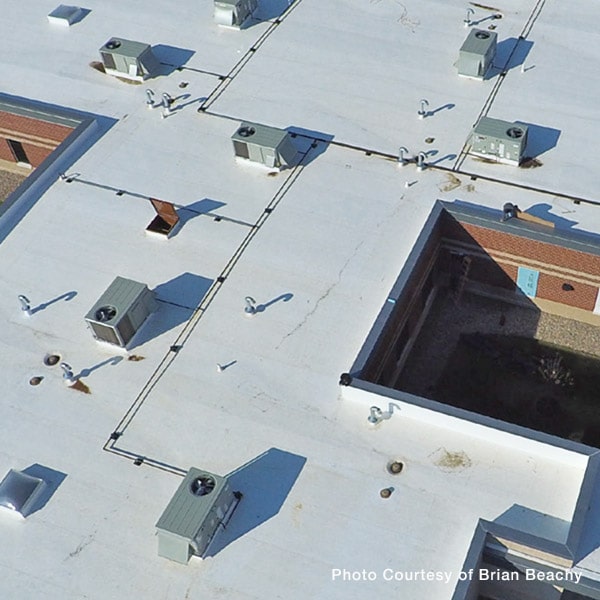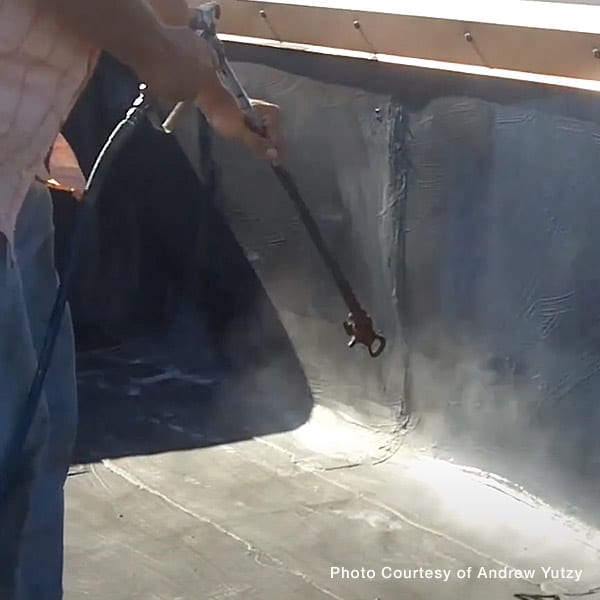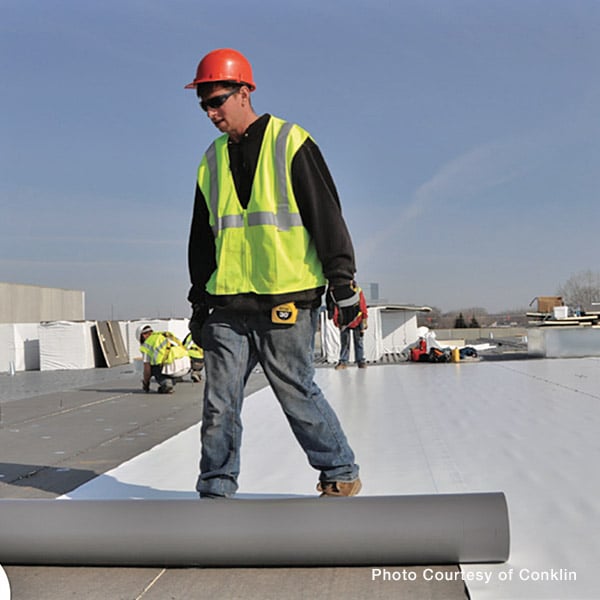Elastomeric Roof Coating
In Pennsylvania, roof leaks are a prevalent issue with various causes, frequently leading to premature roof replacements. The region’s diverse climate encompasses frequent heavy rains and sporadic gale-force winds, which can lead to ponding or pooling water on the roof surface, weakening seams, causing corrosion, and damaging the membrane and flashing. Additionally, the constantly fluctuating temperatures can result in cracks, splits, and blisters on the membrane, allowing outside air, debris, pests, and moisture to penetrate through the roof deck and infiltrate the building. To effectively address these problems, the ideal solution is to apply an elastomeric roof coating to your existing roof.
With over a decade of established expertise, Lester’s Carpentry is a certified contractor of Conklin Roofing Systems. We specialize in delivering cost-effective, energy-efficient, and durable elastomeric roof coatings for commercial roofing systems. Our approach eliminates the need for time-consuming and expensive roof replacements, ensuring a seamless and hassle-free experience for our clients.
What is an Elastomeric?
An elastomeric coating refers to a polymer coating with rubber-like properties that exhibit remarkable flexibility, allowing it to stretch up to twice its original size and recover its shape without any cracks or breaks. When applied to a roof, this coating enables the roof to withstand the natural expansion and contraction that occurs during seasonal weather changes, preventing any potential damage to the roof’s surface. There are three primary types of elastomeric solutions available: acrylic, urethane, and silicone.
Elastomeric Roof Coating
Elastomeric roof coatings offer a resilient and economical solution as an alternative to traditional roof replacement. With a track record since 1977, Conklin’s innovative elastomeric roof coating has consistently delivered exceptional performance in repairing, restoring, and safeguarding diverse roofing systems. Notably, these coatings have successfully extended the lifespan of over two billion square feet of roofs by several decades. All of these remarkable benefits are achieved at a significantly lower cost compared to a full roof replacement.

5 Best Elastomeric Roof Coatings From Conklin
- Benchmark®
- Equinox®
- PUMA® XL
- Rapid Roof III®
- Rapid Roof HV®
We have a repair and restoration solution for your commercial roofing system:
- BUR/EPDM
- Composite Decking
- Concrete
- ISO Board
- Metal
- Modified Bitumen
- PVC/TPO
- Wood
After a thorough roof inspection, we will recommend the appropriate elastomeric coatings that will provide a durable, long-lasting roof repair that will extend its useful life for decades.
Long-Lasting Durability and Leak-Free Shield Prolongs Roof’s Lifespan for Decades
Conklin’s robust and reflective white elastomeric repair coatings and roofing systems offer a revitalizing solution for aged, weathered, cracked, and leaking BUR, EPDM, TPO, and other approved membranes. These coatings provide a reliable waterproof barrier and leak-free protection, effectively extending the lifespan of the roof for several decades. Simultaneously, they significantly enhance energy efficiency. Furthermore, these coatings can be reapplied multiple times throughout the roof’s useful life without imposing a notable increase in the building load.

Benefits of Our Elastomeric Roof Repairs
Our elastomeric roof coatings offer a sustainable and cost-effective option to repair, restore, and safeguard your roofing system. With a solar reflective and waterproof barrier, they provide a reliable and renewable solution without the requirement for a complete roof teardown and replacement.
1. Superior Waterproof Barrier
Elastomeric roof coatings provide an exceptional waterproof barrier that effectively stops and prevents leaks. This advanced roofing technology creates a seamless, flexible membrane over your existing roof, sealing any cracks or gaps and protecting against water infiltration. The superior elasticity of elastomeric roof coatings allows them to expand and contract with temperature fluctuations, ensuring that your roof remains impermeable to moisture, even in challenging weather conditions.
2. White Solar Reflective Surface
The white solar reflective surface of elastomeric roof coatings significantly lowers energy costs. This reflective quality helps to bounce back solar radiation rather than absorbing it, which reduces heat buildup on the roof. As a result, your building remains cooler, and your air conditioning system works more efficiently, leading to lower energy bills. This thermal performance not only enhances comfort inside your building but also contributes to a more energy-efficient and environmentally friendly operation.
3. Sustainable and Renewable
Elastomeric roof coatings are sustainable and renewable for the duration of the roof’s useful life. These coatings are designed to be long-lasting and durable, providing a continuous protective layer that can be renewed as needed. This renewability helps to extend the lifespan of your roof, reducing the need for premature replacements and minimizing waste. By opting for elastomeric roof coatings, you contribute to sustainability efforts and reduce your overall environmental footprint.
4. Easy Maintenance
Maintaining elastomeric roof coatings is straightforward and manageable. With an annual or semiannual roof cleaning, you can ensure that the coating remains in optimal condition and continues to provide effective protection. Regular inspections and cleanings help to address any minor issues before they become major problems, extending the life of the coating and maintaining the performance of your roof.
5. Potential for Financial Incentives
Your business may qualify for various financial incentives, such as tax credits, utility rebates, and other incentives for using energy-efficient roofing solutions. These programs are designed to encourage the adoption of environmentally friendly technologies and can provide substantial savings on the initial cost of the elastomeric roof coatings. Consulting with local authorities and utility providers can help you identify and take advantage of these opportunities.

6. Non-Prorated Extendable Material Warranty
Elastomeric roof coatings often come with a non-prorated extendable material warranty. This type of warranty offers comprehensive coverage for the coating, including protection against defects and performance issues. The extendable nature of the warranty allows you to maintain coverage over an extended period, providing peace of mind and ensuring that you are protected against potential future issues.
7. EnergyStar and Cool Roofing Rating Council Rated
Elastomeric roof coatings are EnergyStar and Cool Roofing Rating Council rated, signifying their superior energy efficiency and environmental performance. These certifications indicate that the coating meets rigorous standards for reflectivity and thermal performance, ensuring that it delivers on its promise of reducing energy consumption and enhancing the sustainability of your roofing system.
8. FM Approved
Elastomeric roof coatings that are FM Approved have undergone rigorous testing and meet the high standards set by FM Approvals for fire resistance, weather performance, and overall reliability. This certification provides additional assurance of the quality and durability of the coating, making it a trusted choice for commercial and industrial applications.
Commercial Elastomeric Roof Repairs in Pennsylvania
For a limited time, Lester’s Carpentry is offering FREE roof inspections for agricultural, industrial, and commercial buildings in Rossiter, Berlin, Meyersdale, Claysburg, and surrounding communities in Pennsylvania. Call to schedule an appointment for a free estimate today.
7 Common FAQs About Elastomeric Roof Coatings
1. How do elastomeric roof coatings improve energy efficiency?
Elastomeric roof coatings enhance energy efficiency by reflecting solar radiation and reducing heat absorption. This reflective property minimizes the roof’s surface temperature, leading to lower cooling costs, especially in hot climates. By applying these coatings, property owners can create a more energy-efficient building, resulting in reduced reliance on air conditioning systems and lower utility bills. This characteristic also contributes to the longevity of the roofing materials beneath the coating, as lower temperatures help prevent premature degradation caused by heat exposure.
2. What surfaces are compatible with elastomeric roof coatings?
Elastomeric roof coatings are versatile and can be applied to various roofing surfaces, including metal, built-up roofs, modified bitumen, and single-ply membranes such as EPDM and TPO. Before application, it’s essential to ensure the surface is clean, dry, and free of debris. Each surface type may require specific preparation techniques, such as priming or patching, to ensure proper adhesion and performance of the elastomeric roof coatings. Consulting with a professional can help determine the best approach for your particular roofing system.
3. How long do elastomeric roof coatings last?
The lifespan of elastomeric roof coatings typically ranges from 10 to 20 years, depending on factors such as climate, maintenance, and the quality of the application. Proper installation by a skilled contractor, along with regular inspections and maintenance, can significantly extend the life of the coating. To maximize longevity, it’s crucial to address any wear or damage promptly and ensure that the roof remains clean and free of debris. When well-maintained, elastomeric roof coatings can provide durable protection and long-term performance.
4. Can I apply elastomeric roof coatings myself, or should I hire a professional?
While some property owners may be tempted to apply elastomeric roof coatings themselves, hiring a professional is highly recommended. Professionals have the experience and expertise to assess the roofing system accurately and prepare the surface properly for application. They also understand the importance of selecting the right products and applying them under optimal conditions to ensure effective adhesion and performance. Additionally, professional installation often comes with warranties, providing further peace of mind regarding the quality and durability of the work.
5. What are the maintenance requirements for elastomeric roof coatings?
Maintenance of elastomeric roof coatings is relatively simple but essential for ensuring their longevity. Regular inspections should be conducted to check for signs of wear, damage, or pooling water. Cleaning the roof periodically to remove debris, dirt, and algae is also crucial, as these elements can degrade the coating over time. If any damage is detected, such as cracks or blisters, prompt repairs using compatible materials are necessary to maintain the integrity of the coating and protect the underlying roofing system.

6. Are elastomeric roof coatings environmentally friendly?
Yes, elastomeric roof coatings are often considered environmentally friendly. Many products are low in volatile organic compounds (VOCs), which contribute to air pollution and smog formation. The reflective properties of elastomeric roof coatings also help reduce the urban heat island effect by lowering surrounding temperatures. Furthermore, by extending the life of the roof and reducing the need for replacement, these coatings contribute to sustainability by minimizing waste. Choosing elastomeric roof coatings aligns with eco-friendly building practices while enhancing the roof’s performance.
7. What is the best time of year to apply elastomeric roof coatings?
The best time to apply elastomeric roof coatings is during moderate temperatures, typically in spring or fall. These conditions allow for optimal curing and adhesion of the coating. It’s essential to avoid extreme temperatures, both hot and cold, as they can affect the application process and the performance of the coatings. Additionally, ensure that rain or moisture is not expected for at least 24 hours after application to allow for proper drying. Consulting with a professional can help determine the best timing based on local weather conditions and specific project needs.

Restoration vs Replacement
Scope of Work
Roof restoration typically involves applying products like elastomeric roof coatings to rejuvenate and extend the life of an existing roof. This process includes cleaning, repairing minor damage, and applying the coating to create a protective layer. In contrast, roof replacement entails removing the entire existing roofing system and installing a new one. Restoration is often less invasive, while replacement requires significant labor and can disrupt daily operations.
Cost-Effectiveness
Choosing roof restoration with elastomeric roof coatings can be more cost-effective than full roof replacement. Restoration allows property owners to extend the lifespan of their roofs without the high costs associated with complete replacement. It usually requires less material and labor, translating to lower expenses. Roof replacement, while sometimes necessary, represents a larger financial investment that can strain budgets, particularly for businesses looking to manage costs effectively.
Time Required
Roof restoration is generally a quicker process compared to roof replacement. Applying elastomeric roof coatings can often be completed within a few days, depending on the size of the roof and the extent of the repairs needed. Conversely, roof replacement can take weeks, as it involves removing old materials, repairing the underlying structure, and installing a new roofing system. The reduced time commitment for restoration minimizes disruption to daily activities, making it a more appealing option for many businesses.
Environmental Impact
Roof restoration with elastomeric roof coatings is typically more environmentally friendly than roof replacement. Restoration reduces waste by reusing existing roofing materials, while replacement generates significant landfill waste as the old roofing system is discarded. Furthermore, elastomeric coatings often enhance energy efficiency by reflecting sunlight, which can lower cooling costs and reduce the building’s overall carbon footprint. This sustainable approach aligns with eco-friendly practices, making restoration a preferred choice for environmentally conscious property owners.
Longevity and Performance
Both roof restoration and replacement can improve a roof’s longevity, but they do so in different ways. Elastomeric roof coatings can add years to the life of an existing roof, providing a protective barrier against UV rays, water damage, and temperature fluctuations. However, once a roof reaches a certain level of deterioration, replacement may become necessary to ensure long-term performance and structural integrity. Property owners should evaluate their roofs’ conditions to determine which option will provide the best long-term solution for their needs.
ENHANCED ENERGY SAVINGS
Elastomeric roof coatings offer excellent energy-saving benefits by reflecting solar heat and reducing the roof’s surface temperature. This “cool roof” effect can lead to significant reductions in energy costs, particularly for commercial buildings in warmer climates. Unlike traditional roof replacement, which may not always include reflective materials, restoration with elastomeric coatings improves energy efficiency as part of the process. The reduction in cooling demands also places less strain on HVAC systems, potentially extending their lifespan. For businesses focused on sustainability and reducing operational costs, elastomeric coatings provide a dual benefit of extended roof life and energy savings.
MINIMAL BUSINESS DOWNTIME
Applying elastomeric roof coatings is a less intrusive process compared to roof replacement, which often involves tearing off old materials and installing a new system. Restoration can be done while the building remains operational, causing minimal disruption to employees, customers, and overall business activities. This advantage is especially critical for businesses where uninterrupted operations are essential, such as retail stores, manufacturing plants, or healthcare facilities. Roof replacement, by contrast, often requires temporary closures or restricted access, potentially resulting in lost revenue. The efficiency and convenience of elastomeric roof coatings make them an attractive option for business owners.

FLEXIBILITY AND VERSATILITY
Elastomeric roof coatings are compatible with a wide range of roofing materials, including metal, single-ply membranes, and modified bitumen. This versatility makes them suitable for restoring various roof types without the need for costly or complex modifications. Additionally, elastomeric coatings come in different formulations designed to address specific challenges, such as ponding water or high UV exposure. This adaptability allows property owners to tailor the restoration process to their roof’s unique needs. In contrast, replacement requires selecting a single roofing system, which may not offer the same level of customization for specific conditions or challenges.
PROACTIVE MAINTENANCE OPTION
Using elastomeric roof coatings as part of a proactive maintenance strategy can prevent small issues from escalating into major problems. The coatings seal minor cracks, gaps, and leaks, providing a waterproof barrier that helps protect the roof from further damage. This preventive approach reduces the likelihood of costly emergency repairs or premature roof failure. In comparison, roof replacement is often a reactive measure taken when significant damage has already occurred. By investing in regular restoration and maintenance with elastomeric coatings, property owners can avoid the expense and disruption associated with unexpected roof replacements.
